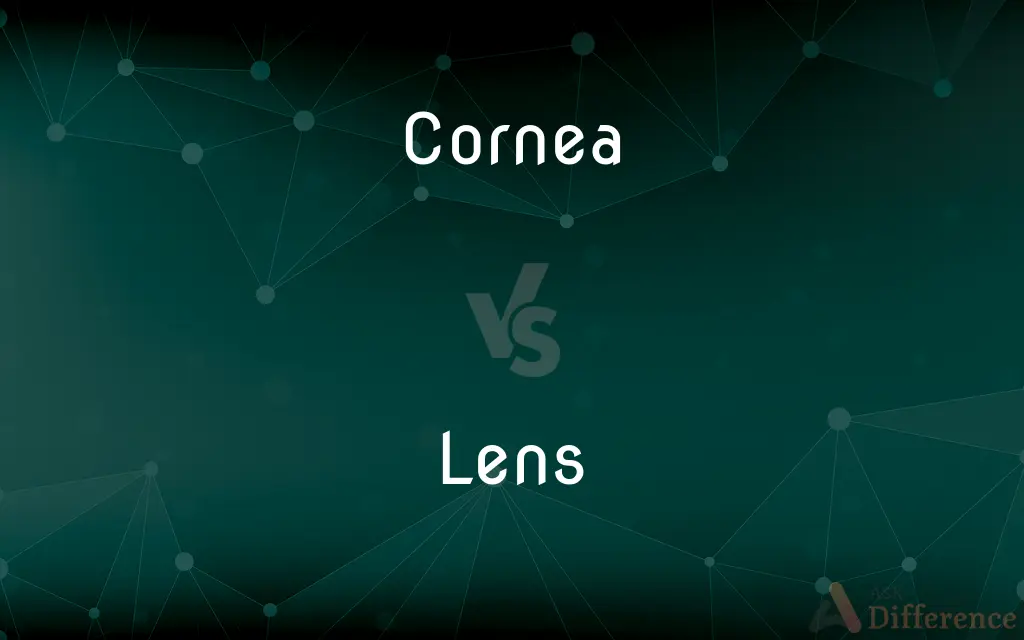Cornea vs. Lens — What's the Difference?
Edited by Tayyaba Rehman — By Fiza Rafique — Updated on March 28, 2024
The cornea is the clear, dome-shaped front surface of the eye, focusing light into the eye, while the lens is a transparent structure inside the eye that further fine-tunes focus to ensure clear vision.

Difference Between Cornea and Lens
Table of Contents
ADVERTISEMENT
Key Differences
The cornea serves as the eye's outermost lens, playing a crucial role in focusing visual images by bending light rays as they enter the eye. It is responsible for about 70% to 75% of the eye's total focusing power. In contrast, the lens is located behind the iris and further adjusts the focus of light rays onto the retina, fine-tuning vision and enabling us to see objects at various distances clearly. This adjustability of the lens is known as accommodation.
While the cornea's shape is fixed, providing a constant focusing power, the lens is flexible, changing its shape to focus light for clear vision at different distances. This flexibility decreases with age, leading to conditions like presbyopia. On the other hand, the cornea's structure can be altered through surgical procedures to correct vision, such as LASIK, demonstrating its unique role in vision correction.
The cornea is made up of five layers, each playing a role in its transparency and refractive properties. It has no blood vessels to maintain transparency but receives nutrients from tears and the aqueous humor. The lens, however, is composed of proteins and water, arranged in a way that keeps it clear and able to change shape. Over time, changes in the lens can lead to cataracts, affecting vision.
In terms of protection, the cornea acts as a barrier against dust, germs, and other harmful particles, playing a critical role in eye health. The lens lacks this protective function but is crucial for adjusting the eye's focus, highlighting the different but complementary roles of these two structures in vision.
Both the cornea and the lens are susceptible to diseases and conditions that can affect vision. For the cornea, conditions like keratoconus can change its shape, affecting vision, while for the lens, diseases like cataracts cloud the lens, leading to vision loss. This underscores the importance of both structures in maintaining clear and healthy vision.
ADVERTISEMENT
Comparison Chart
Location
Outermost front surface of the eye
Inside the eye, behind the iris
Function
Focuses light into the eye
Fine-tunes focus onto the retina
Structure
Fixed shape, made up of five layers
Flexible, changes shape for accommodation
Contribution to Vision
Provides most of the eye's focusing power
Adjusts focus for clear vision at different distances
Age-related Changes
Shape can be altered surgically; not typically affected by age
Loses flexibility with age, leading to presbyopia
Diseases
Keratoconus, corneal ulcers
Cataracts
Nutrient Supply
Receives nutrients from tears and aqueous humor
Encased in a capsule, nourished by the aqueous humor
Compare with Definitions
Cornea
Can be reshaped through surgery to correct vision.
LASIK surgery modifies the cornea to improve eyesight.
Lens
Flexible, allowing it to change shape for focusing.
The lens's flexibility helps in focusing on near and distant objects.
Cornea
The clear, front surface of the eye that focuses light.
The cornea refracts light entering the eye.
Lens
Can become cloudy, leading to cataracts.
Aging can cause the lens to develop cataracts, affecting vision.
Cornea
Lacks blood vessels to maintain transparency.
The cornea's clarity is crucial for vision.
Lens
Loses elasticity over time, affecting near vision.
The loss of lens elasticity results in presbyopia.
Cornea
Made up of five layers, each contributing to its function.
The endothelium is one of the cornea's vital layers.
Lens
A transparent structure inside the eye that focuses light onto the retina.
The lens adjusts to change the focal distance.
Cornea
Acts as a protective barrier for the eye.
The cornea protects the eye from environmental irritants.
Lens
Located behind the iris, contributing to eye color visibility.
The lens works with the iris to regulate light entry.
Cornea
The cornea is the transparent front part of the eye that covers the iris, pupil, and anterior chamber. The cornea, with the anterior chamber and lens, refracts light, with the cornea accounting for approximately two-thirds of the eye's total optical power.
Lens
A ground or molded piece of glass, plastic, or other transparent material with opposite surfaces either or both of which are curved, by means of which light rays are refracted so that they converge or diverge to form an image.
Cornea
The transparent convex anterior portion of the outer fibrous coat of the eyeball that covers the iris and the pupil and is continuous with the sclera.
Lens
A combination of two or more such pieces, sometimes with other optical devices such as prisms, used to form an image for viewing or photographing.Also called compound lens.
Cornea
(anatomy) The transparent layer making up the outermost front part of the eye, covering the iris, pupil, and anterior chamber.
Lens
A thin piece of glass or plastic, as on a pair of sunglasses, that transmits light without refraction.
Cornea
The transparent part of the coat of the eyeball which covers the iris and pupil and admits light to the interior. See Eye.
Lens
A device or phenomenon (such as a gravitational field) that causes light or other radiation to converge or diverge by an action analogous to that of a lens.
Cornea
Transparent anterior portion of the outer covering of the eye; it covers the lens and iris and is continuous with the sclera
Lens
A transparent, biconvex structure in the eye of a vertebrate or cephalopod that is located between the iris and the vitreous humor and focuses light rays entering through the pupil to form an image on the retina.
Lens
A similar structure in many invertebrates.
Lens
(Informal)To make a photograph or movie of.
Lens
To bend or distort (light, for example) by means of a lens, especially a gravitational field.
Lens
An object, usually made of glass, that focuses or defocuses the light that passes through it.
Lens
A device which focuses or defocuses electron beams.
Lens
(geometry) A convex shape bounded by two circular arcs, joined at their endpoints, the corresponding concave shape being a lune.
Lens
(biology) A genus of the legume family; its bean.
Lens
(anatomy) The transparent crystalline structure in the eye.
Lens
(earth science) A body of rock, ice, or water shaped like a convex lens.
Lens
(programming) A construct used in statically-typed functional programming languages to access nested data structures.
Lens
A way of looking, literally or figuratively, at something.
Lens
To film, shoot.
Lens
(geology) To become thinner towards the edges.
Lens
A piece of glass, or other transparent substance, ground with two opposite regular surfaces, either both curved, or one curved and the other plane, and commonly used, either singly or combined, in optical instruments, for changing the direction of rays of light, and thus magnifying objects, or otherwise modifying vision. In practice, the curved surfaces are usually spherical, though rarely cylindrical, or of some other figure.
Lens
A transparent optical device used to converge or diverge transmitted light and to form images
Lens
Genus of small erect or climbing herbs with pinnate leaves and small inconspicuous white flowers and small flattened pods: lentils
Lens
(metaphor) a channel through which something can be seen or understood;
The writer is the lens through which history can be seen
Lens
Biconvex transparent body situated behind the iris in the eye; it focuses light waves on the retina
Lens
Electronic equipment that uses a magnetic or electric field in order to focus a beam of electrons
Common Curiosities
What causes cataracts in the lens?
Cataracts are primarily caused by aging, but other factors like diabetes, smoking, and prolonged exposure to sunlight can contribute.
Are cornea transplants possible?
Yes, corneal transplants are common and successful procedures to replace a damaged cornea with healthy donor tissue.
Can the lens be replaced if it's damaged?
Yes, during cataract surgery, the cloudy lens can be replaced with an artificial intraocular lens to restore clear vision.
How do glasses correct vision problems related to the cornea and lens?
Glasses correct vision by compensating for the cornea's or lens's inability to focus light accurately onto the retina.
Can the cornea heal itself after an injury?
Yes, the cornea has a remarkable ability to heal minor scratches and injuries, but more severe damage may require medical treatment.
Can lifestyle affect the health of the cornea and lens?
Yes, lifestyle factors like smoking, poor diet, and lack of eye protection can affect the health of both the cornea and lens.
How do contact lenses work with the cornea?
Contact lenses sit on the cornea, correcting its focusing power to improve vision for conditions like myopia and hyperopia.
Is LASIK surgery performed on the cornea or the lens?
LASIK surgery is performed on the cornea to reshape it and correct refractive errors such as myopia, hyperopia, and astigmatism.
Why is the lens important for seeing clearly?
The lens fine-tunes the focus of light onto the retina, essential for clear vision at various distances.
What is keratoconus?
Keratoconus is a condition where the cornea thins and bulges into a cone shape, distorting vision.
Are there any preventive measures for cornea and lens health?
Preventive measures include wearing UV-protective eyewear, maintaining a healthy lifestyle, and regular eye check-ups to monitor eye health.
How does the cornea contribute to vision?
The cornea contributes to vision by focusing most of the light that enters the eye, essential for creating a clear visual image.
What is presbyopia?
Presbyopia is an age-related condition where the lens loses flexibility, making it hard to focus on close objects.
How do cataracts affect vision?
Cataracts cloud the lens, leading to a decrease in vision clarity and brightness.
What's the difference between the cornea and the lens in terms of location?
The cornea is the eye's outermost surface, while the lens is located inside the eye behind the iris.
Share Your Discovery

Previous Comparison
Labour vs. Work
Next Comparison
Ight vs. AightAuthor Spotlight
Written by
Fiza RafiqueFiza Rafique is a skilled content writer at AskDifference.com, where she meticulously refines and enhances written pieces. Drawing from her vast editorial expertise, Fiza ensures clarity, accuracy, and precision in every article. Passionate about language, she continually seeks to elevate the quality of content for readers worldwide.
Edited by
Tayyaba RehmanTayyaba Rehman is a distinguished writer, currently serving as a primary contributor to askdifference.com. As a researcher in semantics and etymology, Tayyaba's passion for the complexity of languages and their distinctions has found a perfect home on the platform. Tayyaba delves into the intricacies of language, distinguishing between commonly confused words and phrases, thereby providing clarity for readers worldwide.
















































